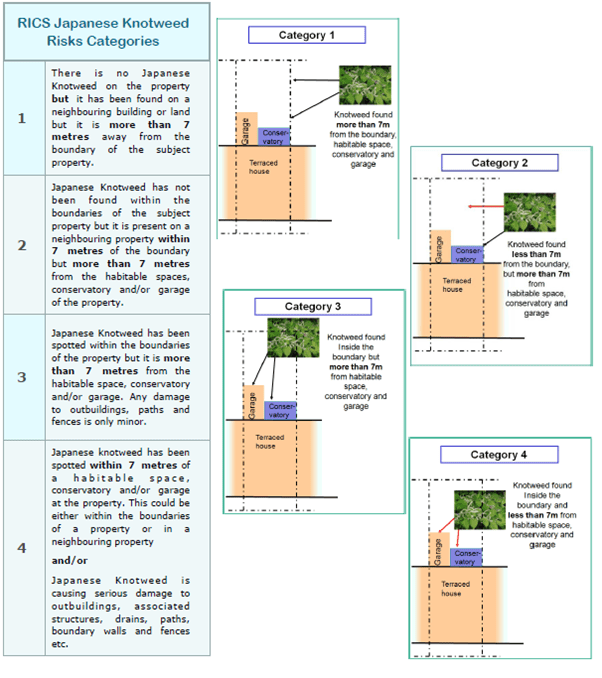Japanese Knotweed.
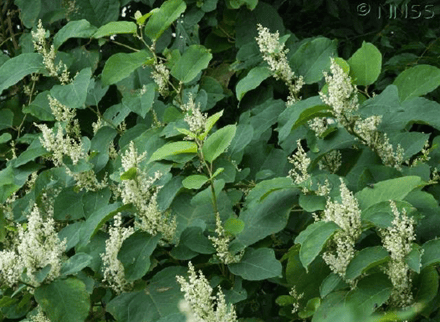
Japanese Knotweed (Fallopia Japonica) is a perennial and, on the face of it, an elegant and attractive bamboo-like plant. However, in the past few years, it has become recognised as one of the most anti-social and talked about plants in Britain and was described by the Environment Agency as “indisputably the UK’s most aggressive, destructive and invasive plant”.
It has a very invasive root structure and the strength and speed of its growth means it can damage buildings, roads, flood defences, drains and other buried services and smother other plants. This led to it being included in the Wildlife and Countryside Act 1981 which makes it an offence to plant or otherwise allow Japanese Knotweed to grow in the wild.
A brief history
Japanese Knotweed was introduced into Europe in the early 19th century and propagated and sold as an ornamental garden plant because it grew quickly and because in its native Japan the plant is well behaved. However, the Victorian gardeners quickly recognised that it could cause some problems and the Royal Horticultural Society advised caution on using it in the early part of the 20th Century, but it was not until sometime later that it was identified as having a destructive quality to structures and other plants.
In Japan its proliferation is kept in check by natural means as there are at least 30 species of insect and 6 species of fungus that feed on the plant. It only became a nuisance when it was removed from its natural habitat where these biological control species did not exist and, with no natural predators, the plant is able to thrive uncontrolled.
The problem
Once it takes hold, Japanese Knotweed grows at a very rapid rate. It is not fussy and can grow in any type of soil.
Above ground it can grow to 3-4m high in just 10 weeks in dense stands, while underground, the plant has an aggressive root system with interlinking rhizomes (used to store food) that grow rapidly. These can spread up to 7m horizontally and the energy and force of this rapid growth can break through solid barriers compromising the physical integrity of structures such as:
Drains and other buried services
Paths, patios, drives etc
Boundary and retaining walls
Outbuildings and conservatories
Gardens
Although rare, it has been known to break through the floor screeds into actual properties. We have seen pictures where the plant has come up through a floor slab into a living room. Luckily, such extreme cases are very rare.
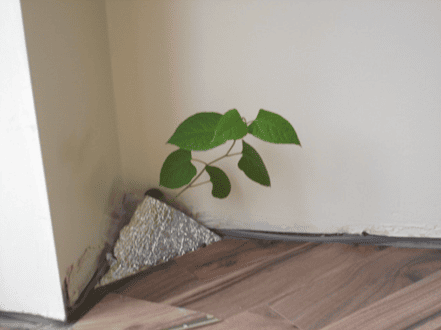
The main way in which it spreads is by human activity—essentially any part of the plant can, if broken off, grow into a new plant. The most common way is for rhizomes to be broken off and spread onto new areas simply through careless management of the waste. In particular, it has been associated with watercourses (streams, rivers, canals etc.) where the water has inadvertently carried plant waste to a new site.
Once established the eradication of the plant can be problematic and expensive. Digging it out can work but due to the depth and spread of the rhizomes re-growth often occurs, while chemical treatments can take upwards of three or four seasons before total eradication is achieved.
Additionally, the disposal of what is now deemed as ‘controlled waste’ needs to be carried out under the Environmental Protection Act 1990 and this essentially means a specialist contractor should be appointed.
The Law
Japanese Knotweed is already covered in the Wildlife and Countryside Act 1981. However, in 2014 an amendment to the Anti-social Behaviour, Crime and Policing Act included Japanese Knotweed and other non-native plant species, the other notable plant being Giant Hog Weed which can have a detrimental effect on human health.
The reason stated by the Home Office is that they “…threaten our native biodiversity by crowding out native species and destabilising river banks. They can also damage forestry, agriculture and infrastructure sectors.” The new powers can be used in two ways:
1. A community protection notice can be used to require a person or a ‘body’ to control or prevent the growth of Japanese Knotweed. Local councils and the police will have the power to issue notices where the conduct of the individual or body is having a detrimental effect on the quality of life of those in the locality. Conduct includes ‘failure to act’. Breach of a community protection notice is a criminal act and an individual or organisation would be liable to a fine.
2. A community trigger is activated by an individual or an organisation (or someone acting on their behalf) to require agencies to deal with a persistent or previously ignored anti-social behaviour problem. The Home Office confirms in its advice note that this can include Japanese Knotweed.

In summary
It is not illegal to have the plant in a garden, but the homeowner should aim to control the plant and prevent it become a nuisance to neighbours etc.
Control can be carried out by the homeowner, but only a specialist company can dispose of the plant or soil which might contain traces of the plant.
Identification
Japanese Knotweed is an herbaceous perennial, i.e. the stems of the plant die down to soil level each winter but some parts of the plant are sustained just below or at surface level and re-growth can occur for an indefinite number of years.
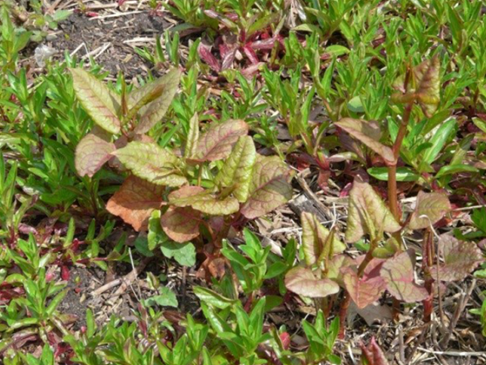
Unlike many other plants in the UK, it does not produce viable seeds–as there is no male Japanese Knotweed partner and instead, it spreads through the root system or via stem cuttings, as mentioned above.
The plant is bamboo-like in structure with shield-shaped leaves. These leaves are arranged in a zigzag pattern along the stem and in late summer they will be accompanied by creamy coloured flower tassels. The stem can vary (depending on the time of the season) from being speckled to a pinkish/red hollow stem, then finally long bare stems in the winter months.
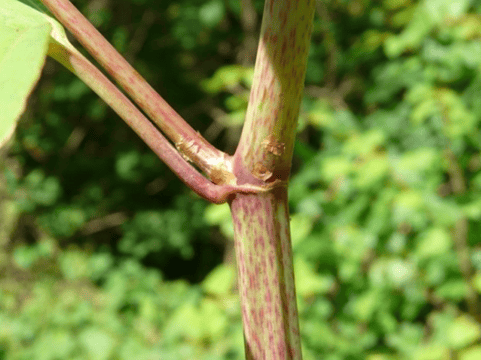
Implications for property–insurance and lending
As well as the potential damage and general hassle that Japanese Knotweed can cause, there are a number of other implications for homeowners:
Many homeowners may not be covered for any damage caused by or the removal of Japanese Knotweed, as many building insurance policies do not cover these. This may get expensive a chemical control can cost several thousand pounds.
When Japanese Knotweed originates from a neighbouring property an insurance company may pursue the owner of that property for the costs of the damage or removal. Therefore, a homeowner may find themselves liable for the costs of knotweed damage/removal on a neighbouring property.
Many mortgage lenders will not grant mortgages on properties affected by Japanese Knotweed which can have obvious implications for owners hoping to sell their property.
Some lenders will not lend on property where Knotweed is identified within 7m of the subject property boundary. This is because the Environment Agency has deemed that the rhizomes can extend up to 7m horizontally and 3m vertically.
Because of the issues outlined, Japanese Knotweed can pose a real ‘threat’ to the property being surveyed.
A recent claim relating to Japanese Knotweed
Recently we had a successful claim against a member of the SAVA Scheme. The surveyor in question was asked by his clients to inspect a property for the purposes of providing a Home Condition Survey.
The property was in an area known to be affected by Japanese Knotweed and the purchasers specifically asked the surveyor to look out for the plant.
The surveyor undertook the inspection, including the rear garden. He took a few general photographs of the garden, but there was no reference in his site notes or the photographs of him looking over any garden fences into neighbouring properties or indeed any accurate location of the photographs. We and the claims investigators had to piece this together.
The photographs he did take indicate that it would have been possible for him to look over the right-hand fence and the rear fence would have been possible as they were accessible and low enough for him to be able to peer over them. A raised flower bed along part of the left-hand fence restricted access to the fence and visibility of the neighbours’ garden on that side. It was not possible to determine from the photographs if this raised bed ran the full length of the garden or was only present along part of that boundary.
Immediately over the accessible fence on the right-hand side of the garden, there was a stand of mixed shrubs. There was a photo taken of the back of the property titled ‘Rear Elevation’ and this stand of shrubs was clearly visible in that photograph. The leaves on one of the plants in the stand were clearly of a heart or shield shape, but it was not possible from the photograph to determine exactly what species of plant were included in the mix of plants.
The surveyor’s clients moved into the property and some months later lodged a claim against the surveyor because they found Japanese Knotweed in their garden.
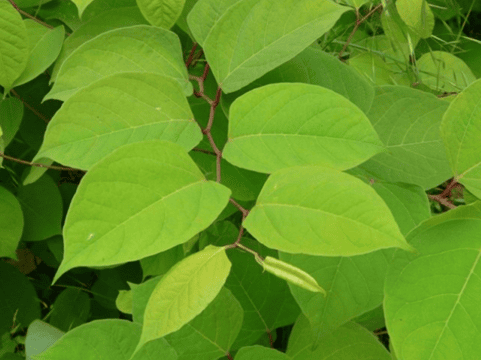
They lodged the claim against the surveyor on the basis that he had missed the Japanese Knotweed present in the adjacent garden.
The claim was actually lodged in court so the insurer instructed a solicitor. However, in order to avoid additional costs, we agreed with the insurers and the solicitor that we should settle the claim prior to the hearing date.
We did so because, based on the photos taken on the day of the inspection, it would have been impossible to dispute the presence of Japanese Knotweed immediately over the fence in the neighbours garden.
The photograph was taken of the back of the property titled ‘Rear Elevation’ clearly showed some vegetation in the neighbouring garden on the right-hand side of the photograph. From the photograph it as difficult to tell whether or not this was Japanese Knotweed and, when enlarged, the photo became too blurred to tell. However, the leaf shape could have been Japanese Knotweed and some of the stems seemed to have had a pinkish tinge.
We reluctantly had to agree with the solicitor that based on this photograph the claimant could rely on making the claim difficult to challenge.
This case reinforces a very important point: most successful claims against surveyors are successful not because the surveyor was negligent, but because they were unable to prove that they were not.
Japanese Knotweed and the SAVA Home Condition Survey
In the light of the successful claim against one of our surveyors and the recent changes in the law, we have reviewed the product rules and the HCS with regards to inspecting for and the reporting on Japanese Knotweed. On reflection, we accept that up to now the product rules have not been completely transparent for the surveyor and that there has not been anywhere to report the presence of the weed, other than in Section G where no condition rating is attributed.
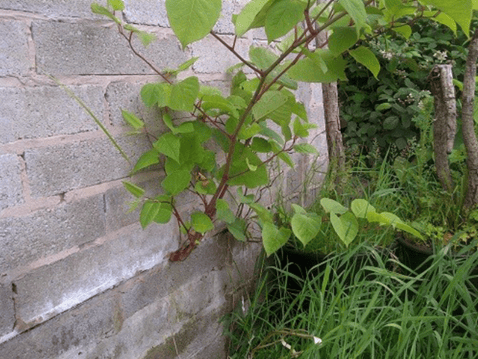
Also, RICS produced a Japanese Knotweed information Paper in 2012 which categorises the risks associated with by Japanese Knotweed into four degrees of severity. The intention is that mortgage lenders can make an accurate and reliable decision on how much finance is offered on properties that have a Japanese Knotweed problem. In practice, the way that individual lenders react to the risks associated with the plant will vary from lender to lender, but the risk categories still provide a useful framework for surveyors.
The four RICS risk categories of severity are listed in the table and further elaborated on in the diagrams on page 6.
RICS suggests that for Categories 3 or 4 a Japanese Knotweed survey is required. For any Japanese Knotweed issues that fall between categories 1-2 the decision to take professional action should be based on a combination of the valuer’s professional judgement and the client’s particular requirements. Therefore, we have introduced an additional reporting requirement.
Reporting on Japanese Knotweed
A new box has been introduced in Section C4 of the HCS report (under Contamination, flooding, etc.), headed Trees and Vegetation. The surveyor will use this section to report on the presence of Japanese Knotweed. The surveyor must also mention Japanese Knotweed in Section G.
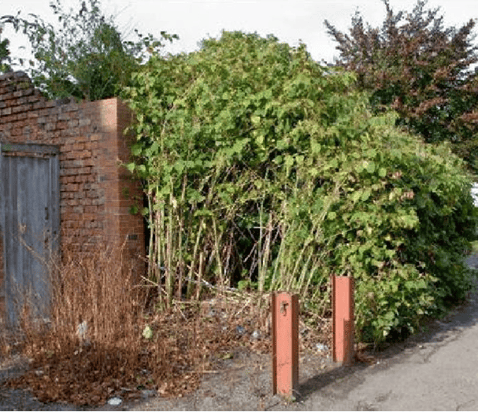
Revision to the Scheme Rules
When carrying out the inspection the surveyor must have consideration to any risks to the property that could originate from outside the boundaries of the subject property. Surveyors must be able to identify Japanese Knotweed at all times of year and must report to their client that they have identified Japanese Knotweed when:
It is within the boundary of the subject property irrespective of how far it is from any buildings or structures;
It is visible on any neighbouring properties within 7m of the boundary of the subject property.
For the avoidance of doubt, a neighbouring property can be any property within 7 meters of the boundary of the subject property and is not restricted to that immediately adjacent property.
When recording the presence or otherwise of Japanese Knotweed, the site notes and photographs together should evidence:
Locations from which the surveyor did a visual inspection of any neighbouring property (note that neighbouring property should only be inspected from within the subject property or from publicly accessible land)
Any limitations that prevented a visual inspection (e.g. high fences, thick shrubs and planting preventing access to the property boundary, etc.)
Any plants that could be mistaken for Japanese Knotweed but are not.
Note that this is very important in light of the case referred to above.
When describing Knotweed in Section G, the RICS risk categories will provide a useful framework in order to provide information for the client, particularly when calling on ‘Further Investigation’.
